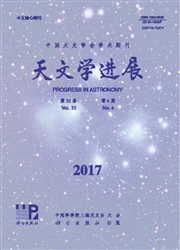

 中文摘要:
中文摘要:
贝叶斯推断是建立在贝叶斯定理上的一种参数估计方法。根据贝叶斯定理,当根据经验,对待估计的参量0的分布密度p(θ)(称为“验前分布”)有所了解时,在给定观测数据D的情况下,可以计算出待估参数θ的“验后分布”——p(θ|D)。p(θ|O)反映了观测结果对p(θ)的修正。所有贝叶斯统计推断都是以验后分布为基础的。贝叶斯估计法是数据分析中的有力工具,其在伽玛暴(GRBs)数据分析窗口展现了多方面的应用,例如分析光变结构,确定参数分布,检验是否存在某种谱线特征,比较和选取模型,等等。
 英文摘要:
英文摘要:
Bayesian method is based on Bayes' Theorem in which one deems it sensible to consider a probability distribution function (pdf) for the unknown parameter θ, p(θ), called the "prior" pdf for θ. p(θ) reflects our knowledge before observation. We let p(θ|D) be the "posterior" pdf of θ (given the data D), which reflects our modified beliefs after incorporating the results of the observation. All Bayesian inferences are based on the posterior distribution. Bayesian approach is a powerful tool for the gamma ray bursts (GRBs) data analysis, such as analyzing structure in photon counting data, combining different lightcnrves, determining various parameters' distributions, testing if there is spectral line, and so on. During the last decade, more and more astronomers realized the potential of the Bayesian ap- proach. Our aim here is not to provide a detailed explanation of Bayesian theory but rather to show what we have learned from GRBs data analysis by using Bayesian approach. As a comparison, we first give a brief introduction to frequentist approach and Bayesian approach. Then, we present spe- cific examples to study various characteristics of GRBs by using Bayesian method. We emphasize the following aspects: using the BIC (Bayesian information criterion) to select model, using BB (Bayesian block) analysis to find optimal change-points in GRBs light curves, using Bayesian fit method to estimate GRBs peak energy, using this method to extend the Hubble diagram to a very high redshift. Bayesian approach has two mainly usages in GRBs data analysis: model selection and parameter estimation. To some degrees, Bayesian approach requires a great deal of thought about the given situation to apply sensibly, therefore, it seemed to need more techniques and experiences.
 同期刊论文项目
同期刊论文项目
 同项目期刊论文
同项目期刊论文
 期刊信息
期刊信息
